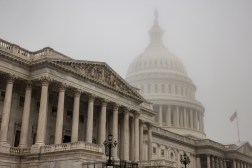GSA: New software deal could save agencies millions

A new governmentwide purchasing deal with geospatial intelligence software firm Esri could save federal agencies millions every year in more efficient, less duplicative contracts, according to the General Services Administration.
The new deal, which follows a model hammered out between Esri and the Office of the Director for National Intelligence on behalf of the 17 U.S. spy agencies, is one of the first fruits of the Obama administration’s efforts — bolstered by the Federal IT Acquisition Reform Act, or FITARA, passed last year — to reign in the duplicative, expensive and notoriously poorly managed way federal agencies buy software licenses.
The new agreement modifies the existing terms of the GSA’s Schedule 70 governmentwide vehicle for IT products and services so it can replace the more than 40 individual agency contracts for Esri software across the U.S. government. By leveraging federal buying power, reducing the inefficiencies of duplicative contracting and increasing transparency on terms and conditions, GSA expects agencies will save more than 5 percent on Esri’s offerings when they transition from their existing deals onto the new agreement, Mary Davie, assistant commissioner of GSA’s Office of Integrated Technology Services, wrote in a blog post this week.
With federal agencies spending $74 million on Esri software each year — roughly a quarter of the total $294 million annual governmentwide spend on geospatial software — GSA believes the discounts “should result in millions in savings each year,” wrote Davie.
She added that “innovative projects like this help agencies better meet their missions, with a direct and positive impact for the American taxpayer.”
GSA partnered with Office of Management and Budget procurement officials and key Esri users from the Army Corps of Engineers, the Department of Navy, the Department of Agriculture and the Department of the Interior to build out an agreement that met the needs of as many federal Esri customers as possible.
Esri executives say its involvement started years back when lawmakers began discussing potential legislation that would eventually become FITARA. Jeff Peters, director of global national government sales at the company, told FedScoop that for the last 18 months Esri has been brainstorming ways in which it could make its products FITARA-compliant — that is, help agencies to buy its software more efficiently and effectively. He said the ODNI BPA worked as a precursor to this latest deal.
“I think we learned a lot from that,” Peters said. “The IC BPA was implemented to bring about uniform acquisition across the IC. It literally let the IC leverage its buying power and it allowed a single contract vehicle, which was great for the government, and frankly it was great for Esri.”
For those same reasons, Peters said, Esri is looking forward to this latest agreement with GSA. “It was a win-win,” he said.
FedScoop first reported the news of the GSA’s governmentwide agreement with Esri in a December 2015 story about the Office of Management and Budget’s new guidance on better software licensing consolidation and management, which calls for the administration to negotiate more such agreements. The head of the Office of Federal Procurement Policy Anne Rung told FedScoop the agreement would be the first of four the government planned to release in the coming year.
“We know there’s 41 separate agreements across government [for Esri products],” Rung said. “And you know it’s inefficient for us.”
Prior Esri customers can begin to join the modified Schedule 70 agreement once their existing contracts expire. GSA and OMB, as part of FITARA, will continue to explore similar opportunities to strike agreements with key software providers, Davie said.
GSA, in a similar move, developed a $503 million blanket purchase agreement for Salesforce products and services Just before Christmas. That BPA, likewise, aims to drive efficiency using the more centralized authorities afforded by FITARA to consolidate the large array of development, support and operational products the government buys from the cloud computing and customer relationship management giant into one procurement vehicle.






